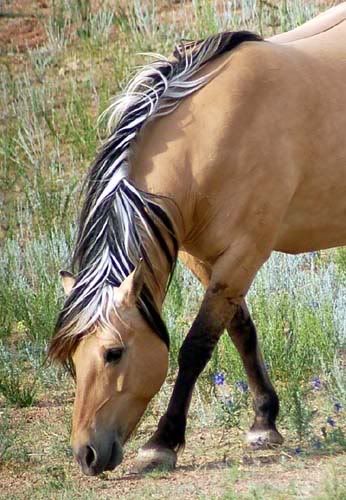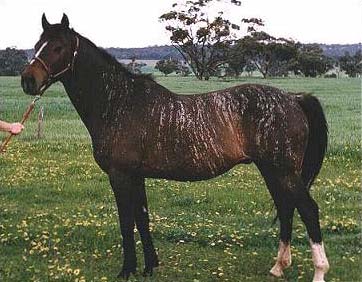Most people can identify whether or not a horse is brown, black or white. People who’ve spent more time around horses (and horsepeople) will know the difference between chestnut, brown and bay, grey and white, black and true black. People who’ve spent even longer around horses, reference books, google and all kinds of other horse enthusiasts will know that there are even more colours out there.
Akhal-Teke Metallic Sheen Colours
Unique to this long-bodied desert breed is its tendency towards metallic sheens in its coat colours. Other breeds have been known to have similar sheens, but not quite to the same level as the Akhal Teke. The exact genetic cause for this has not yet been identified. Not all Akhal-Teke have a metallic tint to their coat, but here are some examples:
Palomino with metallic sheen
Akhal-Teke also frequently have blue eyes, or one blue and one brown eye, as well as splashy white markings (sabino or rabicano).
More discussion on this colour can be found here:
http://www.cgakhaltekes.com/index_files/Page2110.htm
http://www.akhal-teke.org/horse-color.html
Norwegian Fjord Ponies
These distinctive ponies feature a range of dun shades, similar to European and Asian wild horses, Tarpans, and Przewalski horses. They also have a distinctive mane colouring.
 From left to right, these colours are red dun (chestnut and dun parents), dunalino (dun and palomino parents), grullo (black and dun parents), brown dun (bay and dun parents), and white dun (buckskin and dun parents).
From left to right, these colours are red dun (chestnut and dun parents), dunalino (dun and palomino parents), grullo (black and dun parents), brown dun (bay and dun parents), and white dun (buckskin and dun parents).
When left to grow, their manes look something like this:
 Fjords show what are known as “primitive” horse markings, which include the dorsal eel stripe (the dark line down their backs) and zebra bar markings, which are the occasional stripes on their legs. White marks are unusual.
Fjords show what are known as “primitive” horse markings, which include the dorsal eel stripe (the dark line down their backs) and zebra bar markings, which are the occasional stripes on their legs. White marks are unusual.
More information about Norwegian Fjords can be found here: http://www.bluebirdlane.com/the-colours-of-the-norwegian-fjordhorse.html
Unusual Markings
These are not restricted to any breed, but do tend to occur more often in spotted or paint types.
This is called a badger face:
This is called reverse brindle:
These horses are chimeras, resulting from the fusion of fraternal twins in utero, resulting in two sets of DNA in one horse, and very strange coat colours:
These are Somatic mutations, where genes are sometimes “switched off”, creating odd patches of colour.
There are lots of other fascinating colour options out there; this is just the tip of the iceberg!
Apologies if I miss next Monday’s post. I will be travelling from Australia to the UK and probably end up stuck in all of the internet-free spots…








Reblogged this on michaelmustafam and commented:
Interesting. Must read more.
Love the Fjord photo. It’s one of my long time favorites that so perfectly shows the Fjord colors. I would like to throw out there that Fjords don’t have chestnut or black or any of the regular colors. They are all dun. You aren’t going to see any matings between a chestnut and dun Fjords. Supposedly, there are ordinary colored Fjords out there, but I have yet to see one that is a verified purebred. The five colors you see in that photo are the five that you are going to see with the exception of the cremello Fjords. Norway will not register the cremellos because they are big on survival and function and the cremellos often suffer from sun sensitivity. I believe they can be registered in the US.
Also, if you are interested in the “proper terms” for each color that you will hear used among the breed community (at least in the USA), from left to right they are red dun, yellow dun, grey dun, brown dun, and white dun. In Norway, from left to right, they are rødblakk, gulblakk, grå, brunblakk, and ulsblakk. The whites are called kvit.
As far as markings go, they are not desired and are thought to have been introduced many, many years ago when Fjord owners were forced to outcross to the Dole by the powers that be for a purpose I can’t remember. Anyhow, the farmers who owned the Fjords put their foot and down and said no after a while and had to carefully bring the breed back to what it was supposed to be, hence the white markings that crop up. They come from the Dole, not the Fjord. In Norway, Fjords with white markings anywhere but on the forehead will not be approved for breeding. Stallions cannot have any white and mares may have a tiny white star. The reason for this is that a stallion with white will produce far more foals in his lifetime than a mare with white so a little bit of leniency is given to the mares for the sake of the gene pool.
Anyhow, I don’t know if you care, but you cared enough to put this page together so here’s the information if you want it! 🙂